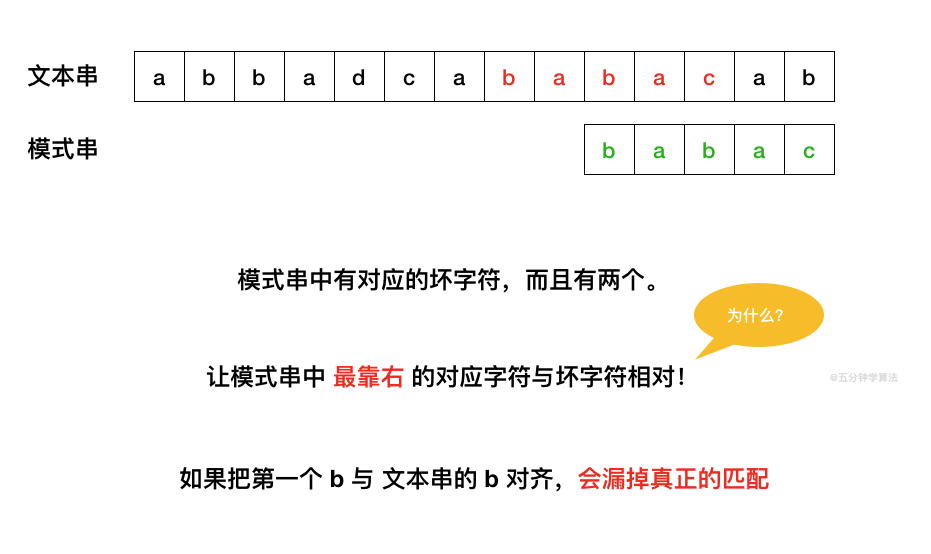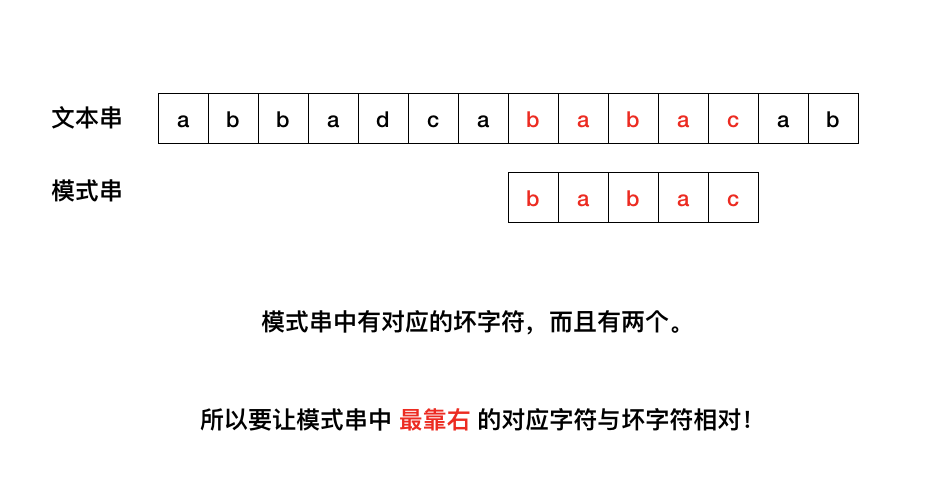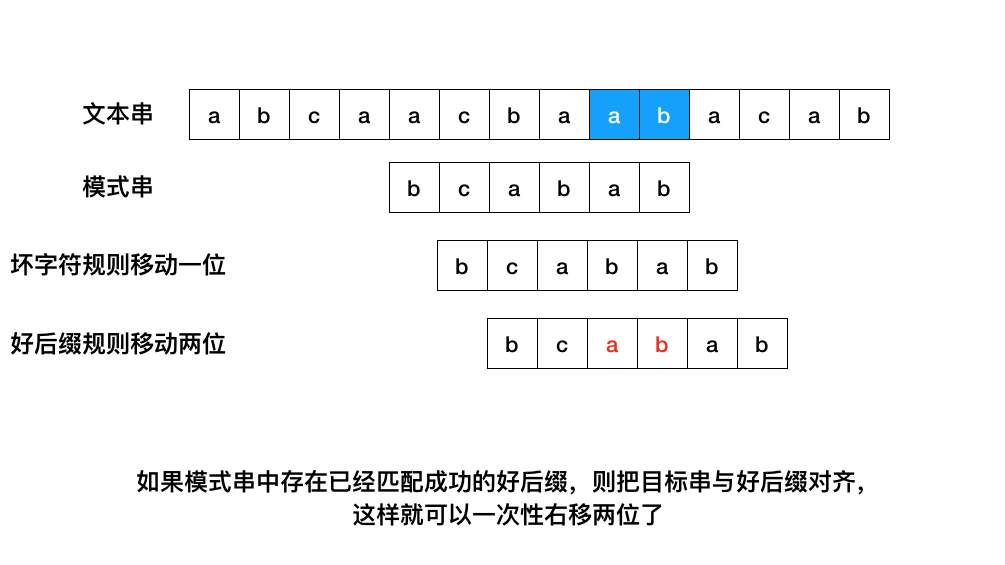字串匹配的Boyer-Moore演算法
阿新 • • 發佈:2020-03-06
# BM演算法介紹
各種文字編輯器的 "查詢" 功能(Ctrl+F),大多采用 Boyer-Moore 演算法。

Boyer-Moore 演算法不僅效率高,而且構思巧妙,容易理解。1977 年,德克薩斯大學的 Robert S. **B**oyer 教授和 J Strother **M**oore 教授發明了一種新的字串匹配演算法:**Boyer-Moore** 演算法,簡稱 **BM 演算法**。
該演算法 **從模式串的尾部開始匹配**,且擁有在最壞情況下 O(N) 的時間複雜度。有資料表明,在實踐中,比 KMP 演算法的實際效能高,可以快大概 3-5 倍。
`BM 演算法中有兩個核心規則:壞字元規則與好字尾規則`
# 定義
**BM演算法** 的一個特點是當不匹配的時候 **一次性可以跳過不止一個字元** 。即它不需要對被搜尋的字串中的字元進行逐一比較,而會跳過其中某些部分。通常搜尋關鍵字越長,演算法速度越快。它的效率來自於這樣的事實:對於每一次失敗的匹配嘗試,演算法都能夠使用這些資訊來排除儘可能多的無法匹配的位置。
它充分利用待搜尋字串的 **一些特徵** ,加快了搜尋的步驟。
那它是利用了什麼特性去 **排除儘可能多的無法匹配的位置** 呢?
它是基於以下兩個規則讓模式串每次向右移動 **儘可能大** 的距離。
- 壞字元規則(**bad-character shift**):當文字串中的某個字元跟模式串的某個字元不匹配時,我們稱文字串中的這個失配字元為壞字元,此時模式串需要向右移動,移動的位數 = 壞字元在模式串中的位置 – 壞字元在模式串中最右出現的位置。此外,如果”壞字元”不包含在模式串之中,則最右出現位置為 -1。**壞字元針對的是文字串。**
- 好字尾規則(**good-suffix shift**):當字元失配時,後移位數 = 好字尾在模式串中的位置 – 好字尾在模式串上一次出現的位置,且如果好字尾在模式串中沒有再次出現,則為 -1。**好字尾針對的是模式串。**

# **壞字元規則**
壞字元出現的時候有兩種情況進行討論。
1、**模式串中沒有出現了文字串中的那個壞字元**,將模式串直接整體對齊到這個字元的後方,繼續比較。


2、模式串中有對應的壞字元時,讓模式串中 **最靠右** 的對應字元與壞字元相對。
這句話有一個關鍵詞是 **最靠右**。
思考一下為什麼是 **最靠右**?
看圖!




### 實現程式碼
```cpp
//計算壞字元陣列bmBc[]
void PreBmBc(char *pattern, int m, int bmBc[]) {
int i;
for (i = 0; i < 256; ++i)
{
bmBc[i] = m;
}
for (i = 0; i < m - 1; ++i)
{
bmBc[pattern[i]] = m - i - 1;
}
}
```
# **好字尾規則** Case 1、如果模式串中存在已經匹配成功的好字尾,則把目標串與好字尾對齊,然後從模式串的最尾元素開始往前匹配。   Case 2、如果無法找到匹配好的字尾,找一個匹配的最長的字首,讓目標串與最長的字首對齊(如果這個字首存在的話)。**模式串[m-s,m] = 模式串[0,s]** 。   Case 3、如果完全不存在和好字尾匹配的子串,則右移整個模式串。 ```cpp //計算好字尾陣列 void PreBmGs(char *pattern, int m, int bmGs[]) { int i, j; int suff[SIZE]; //SIZE 256 // 計算字尾陣列 suffix(pattern, m, suff); // 先全部賦值為m,包含Case3 for(i = 0; i < m; i++) { bmGs[i] = m; } // Case2 j = 0; for(i = m - 1; i >
using namespace std;
#define MAX_CHAR 256
#define SIZE 256
#define MAX(x,y) (x)>(y)?(x):(y)
void BoyerMoore(char *pattern, int m, char *text, int n);
int main() {
char text[256], pattern[256];
while (1)
{
scanf("%s%s", text, pattern);
if (text == 0 || pattern == 0) break;
BoyerMoore(pattern, strlen(pattern), text, strlen(text));
printf("\n");
}
return 0;
}
//計算壞字元陣列bmBc[]
void PreBmBc(char *pattern, int m, int bmBc[]) {
int i;
for (i = 0; i < 256; ++i)
{
bmBc[i] = m;
}
for (i = 0; i < m - 1; ++i)
{
bmBc[pattern[i]] = m - i - 1;
}
}
/*
suff陣列的定義:m是pattern的長度
a. suffix[m-1] = m;
b. suffix[i] = k
for [ pattern[i-k+1] ...,pattern[i]] == [pattern[m-1-k+1],pattern[m-1]]
*/
void suffix_old(char *pattern, int m, int suff[])
{
int i, j;
suff[m - 1] = m;
for (i = m - 2; i >
# **好字尾規則** Case 1、如果模式串中存在已經匹配成功的好字尾,則把目標串與好字尾對齊,然後從模式串的最尾元素開始往前匹配。   Case 2、如果無法找到匹配好的字尾,找一個匹配的最長的字首,讓目標串與最長的字首對齊(如果這個字首存在的話)。**模式串[m-s,m] = 模式串[0,s]** 。   Case 3、如果完全不存在和好字尾匹配的子串,則右移整個模式串。 ```cpp //計算好字尾陣列 void PreBmGs(char *pattern, int m, int bmGs[]) { int i, j; int suff[SIZE]; //SIZE 256 // 計算字尾陣列 suffix(pattern, m, suff); // 先全部賦值為m,包含Case3 for(i = 0; i < m; i++) { bmGs[i] = m; } // Case2 j = 0; for(i = m - 1; i >
